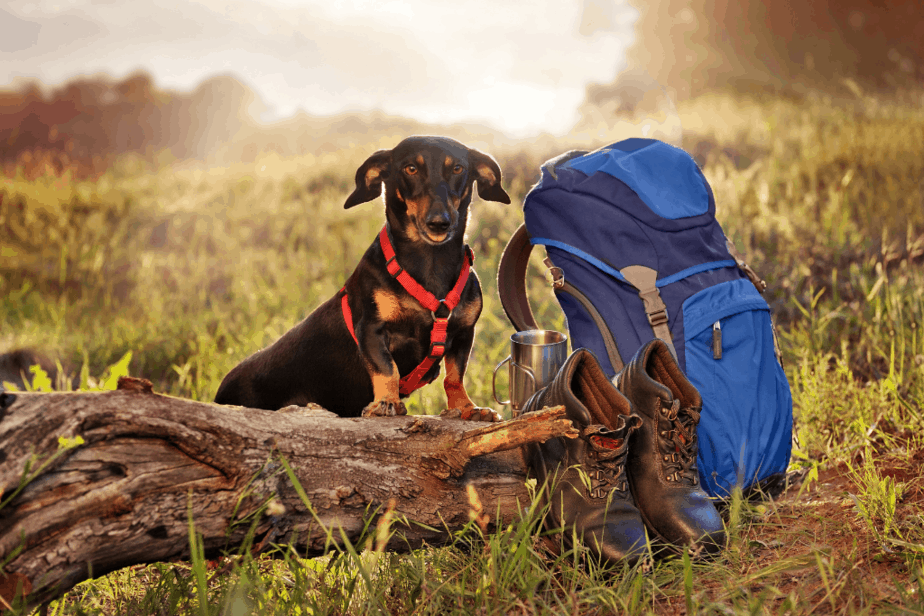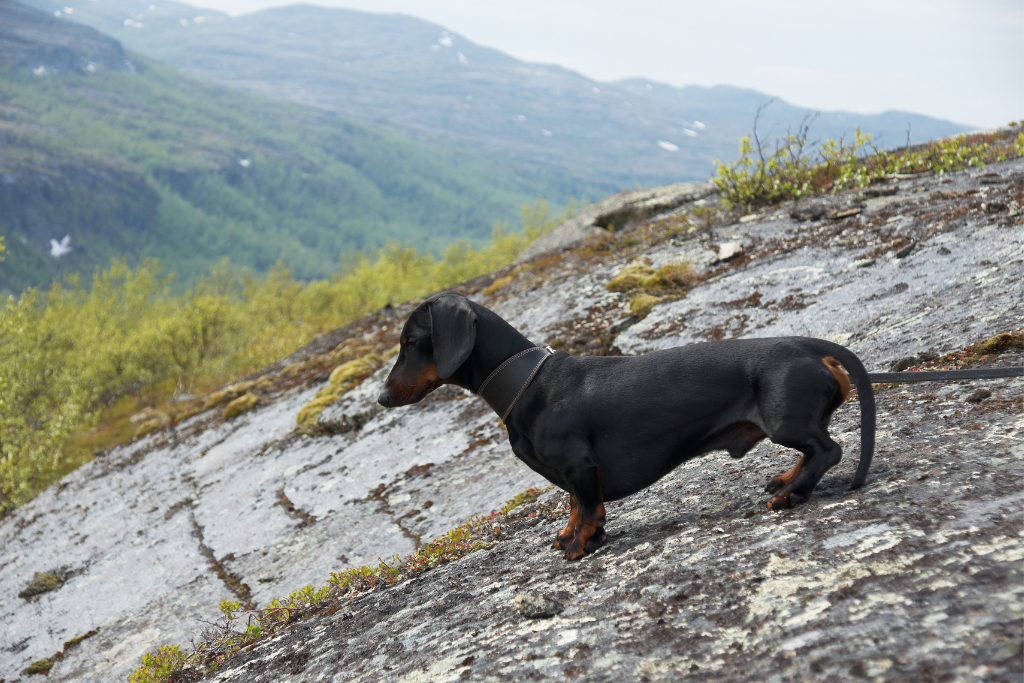Hiking with your dachshunds is a great way to get exercise and explore the outdoors, however, it’s always important to prepare for any potential hurdles that may come up,
while hiking with your furry friend which we are going to explore in this article to make hiking with your dog more fun.
We will also cover everything from picking the right dog backpack, to hiking with your dachshunds in a group and following commands.
Having your dog learn commands is especially important because they may need some help while out on the trail and it’s up to us as their human companions to keep them safe.
10 Tips For Hiking With Dachshunds
Note: These are general guidelines that should be followed when hiking with any breed of dog but we have provided more specific advice based on what type of dachshund you have (standard, long-haired, or wirehair) so make sure you read through all our tips before hitting the trails!

1. Pick The Right Dog Backpack
Choosing the right backpack for your pup is crucial because it will help them maintain their balance and avoid them getting injured.
You want a backpack that can not only hold all your hiking gear “but” can also be used as a carrier if your dog gets too tired.
When purchasing a dog backpack it’s a good idea to make sure they have safety straps (For extra support) so that the backpack doesn’t slip from side to side if you’re carrying your dog.
Dog Backpack Key Features:
- Fully ventilated sides
- Safe & Large capacity
- Made of High-quality materials
- Adjustable dual side pockets
- Front Pack & Back Pack Carrier
- Adjustable chest and waist straps
You may also want to think about investing in an adjustable dog harness or chest belt as this should provide enough support and keep your furry friend close by at all times while out on the trails!
2. Hiking With Dachshunds In A Group
If you want to hike with other dogs (or people), make sure everyone stays within sight distance of each other. The last thing you want is for anyone to get lost on their trail.
If there are any off-leash areas, then only let your dachshund off the leash if they are completely trustworthy with commands.
3. Teaching Commands To Your Dachshund
If your dog is not very experienced at following commands, it may be worth taking them to a training class before you head out on any hikes where there might be a lot of distractions.
The level of command that should start teaching depends on how well trained your pup currently is and what their needs are when out in nature.
If they have trouble seeing over rocks or navigating around tree roots then we recommend using verbal cues such as “watch my feet” so that they can see where you’re going instead!
4. Walk With Your Dachshund Side-by-Side
If your dog is on the shorter side, it’s important to walk with them side by side so that they can see where you’re going. This will also help train their eyesight and make them more comfortable when outside in nature.
5. Pay Attention To Temperature And Hot Surfaces
It may be a great idea to bring an extra water bottle for yourself as well,
because during warmer months hot surfaces such as asphalt or blacktop can cause harm while hiking with dachshunds if not kept properly hydrated.
It’s recommended to stay off of these surfaces at all times but if you’ve been walking for a while and need relief from the heat, it’s always a good idea to take your pup off of the trail and rest in shaded areas.
6. Be Careful Of Low-Hanging Tree Limbs
If you’re hiking with dachshunds or any other breed for that matter, it’s important to watch out for low-hanging tree limbs as these could be hazardous if they are not seen quickly enough!
It may also help to avoid heavily wooded trails during hot months when there is more potential for trees to have fallen due to high heat.
7. Avoid Common Allergy-Causing Plants
It would probably be safest (and most logical) to stay away from common allergy-causing plants such as poison ivy, oak, and sumac.
These plants are considered to be more potent during the summer months which is why it would make sense for us to avoid them if possible!
8. Pay Attention To Your Dachshund’s Behavior
If you find your pup smelling or licking something on a hike, don’t touch whatever they’re sniffing at without first assessing what type of plant or animal that might be before proceeding any further (especially when hiking with dachshunds in an unfamiliar environment).
This goes for anything from eating unknown mushrooms to drinking water out of streams we have not seen fit to drink beforehand.
If you do happen upon any edible fruit along the way then consider taking only one bite so as not to overfill their stomach and potentially cause any digestive problems.
9. Know When It’s Time To Turn Around
If your dog appears to be having trouble on a particular hike, it may be time to turn around if they are not feeling completely safe or comfortable anymore.
This is especially important when hiking with dachshunds as smaller breeds usually need more breaks than larger ones!
If at all possible try to find an area where you can take them off of the trail safely so that they have room in case their feet start going numb from being exposed too long (this will also provide some relief for you!)
The last thing we want is for our pup to end up sprawled out on the ground after getting tired and frustrated while trying to walk.
10. Bring A First Aid Kit
If you want to make sure that your pup is as safe and comfortable as possible while hiking,
it’s always a good idea to bring along an emergency first aid kit just in case of any unforeseen accidents or injuries!
The most important things we recommend bringing are bandages for their paws if they happen to get scraped up on the trail (especially when there might be hidden rocks under leaves).
You can use antiseptic wipes for small wounds and a type of gauze roll so that any large wounds can be covered easily during the hike back out.

What To do you if your Dachshund refuses to walk?
If this happens don’t try to force them by pulling on their leash, as this can result in negative interaction.
Instead, use a toy they like to grab their attention and make walking more fun for both of you!
If that doesn’t work then it could be what they are wearing that is causing discomfort.
If you are using a harness check the straps to make sure they are not loose.
Loose strips on the harness can cause rubbing on the dog’s skin a possible reason they are refusing to walk.
If they are wearing boots check them as well. It could be that their nail is too long for the boots again causing discomfort.
How Far Can Dachshunds Hike?
This depends on many factors like the type of terrain, age, health, fitness, and how often they go walking.
There are some that can handle a marathon but it’s not as common for this type of breed.
Typically in their prime, they can walk 3 to 5 miles without any major issues.
However, they will need to stop every now and then for water breaks or a break from the heat.
If your dog is not used to walking this far then it can cause pain on their joints and muscles which is not good for their health. So be patient! and make sure you start off slow.
Start with shorter distances and build up as they get stronger! This will help them have less chance of injury as they are able to do so gradually.
Benefits Of Hiking With Dachshunds
- Exploring New Areas: The best part about hiking with your dog is just how much you both can explore together.
- Even if they are small and not capable of going on difficult hikes, there are still seen around every corner!
- Exercising: Hiking also allows for a great workout! If you’re walking for more than one hour, take breaks in order to keep from getting too tired out. This could be something as simple as sitting down or drinking water while the dogs hang out next to you
- Mixing With Other Dogs: Dogs love to socialize and if you happen to be at a park withanother pup around! let them say hello, There’s nothing better than meeting new friends out on the trail.
Saftey Tips
- Protect Their Paws: Dogs should wear boots or socks that protect their paws from sharp rocks and prickly plants while walking. The pads of the feet can blister if it gets stepped on repeatedly by rough surfaces or stones. Loose gravel will also scratch them up quickly so avoid those types of footpaths too!
- Dog Drinking Out Of Puddles: Do not let your pup drink out of puddles or streams. Standing water can be a breeding ground for parasites that could give them an upset stomach, diarrhea, or vomiting! Always check the safety before allowing them to take any sips from natural sources like rivers, lakes, etc.
- Weather Conditions: Always check the weather before going on a hike with your dog. If it’s too hot, they might overheat and get heatstroke. Too cold and they could get hypothermia or frostbite. If you’re hiking with your dog in the summer, be aware of ticks and insects that bites them while exploring!
- Make Sure You Plan Your Journey: Always plan your hike and make sure you have a map with you at all times! although these days we can simply look at our phones for directions you may find that the best locations for hiking have no reception.
- Use a harness for security: When hiking with your dog, it is recommended that they wear a harness to keep them from pulling too hard on their leash. If there is any tension or pressure in the neck it can lead to things like spinal disc disruption and other serious injuries as well!
- Walking distance: Make sure your dog is used to walking most days and that they can handle walking at least a mile before taking them on long hikes. If this isn’t something you are used to doing, start slowly with shorter distances and build up over time.
- Dog clothes: Dogs should wear clothes when hiking in winter conditions and may need extra protection from extremely cold temperatures like people to do, too! If they are sensitive then their paws could freeze if going over snowy surfaces (and just like us humans who fall prey to frostbite, this is an issue).
Accessories
The key to having a good hike with your dog is having the right accessories that will help you and your pup have the best experience – especially if it’s their first time on the trails! So here are some more helpful tips for hiking with your four-legged friend.
Food & Water
Make sure you take plenty of bottled water with you on your hike so both you and your dog stay hydrated and watch for signs of overheating or excessive panting – this is the body’s way of telling us that they need to drink more water!
In hot weather especially, it can be hard for humans and dogs alike to find enough cool drinking water so make sure you have plenty with you at all times.
If your dog has been used to eating kibble at home then it will be okay as an occasional snack while you hike but don’t feed them solely from their bowl.
Poop Bags
Don’t forget the poop bags! If you want to keep your dog’s paws clean as well as others’ shoes from getting what they stepped in on – use poop bags just for their business so it doesn’t get tracked all over natural areas.
In some countries, it’s also law to clean up after your dog when they do their business. If not you could face a hefty fine!
Clothing
Dogs should wear clothes when hiking in winter conditions because they are usually sensitive to cold temperatures like people are.
They don’t want their paws getting too cold from going on snowy surfaces either!
It doesn’t take much time before they feel unsafe or start shivering uncontrollably. And just like any other clothing item, pay attention if there is anything rubbing against them uncomfortably – that could be a sign of an allergic reaction or irritation.
Gear
Don’t forget your dog’s own gear like their water bowl, food dish, and dog backpack during your hike!
There’s always something that needs tending to but don’t worry about what all goes into bringing along as long as you’re prepared for emergencies.
Conclusion
If the weather is hot or humid and your hiking water is your new best friend! So keep in mind that dogs may need more water breaks than usual. It’s always best to keep them hydrated by providing freshwater from a bottle.
Also, it’s very important to keep an eye on their paws when going on long hikes.
Dogs’ paws are vulnerable since there is no fur protection on them like other parts of their body. Something to keep in mind!
The bottom line is dogs can make great companions when out hiking if you take care of them they will take care of you.
Related Article:

